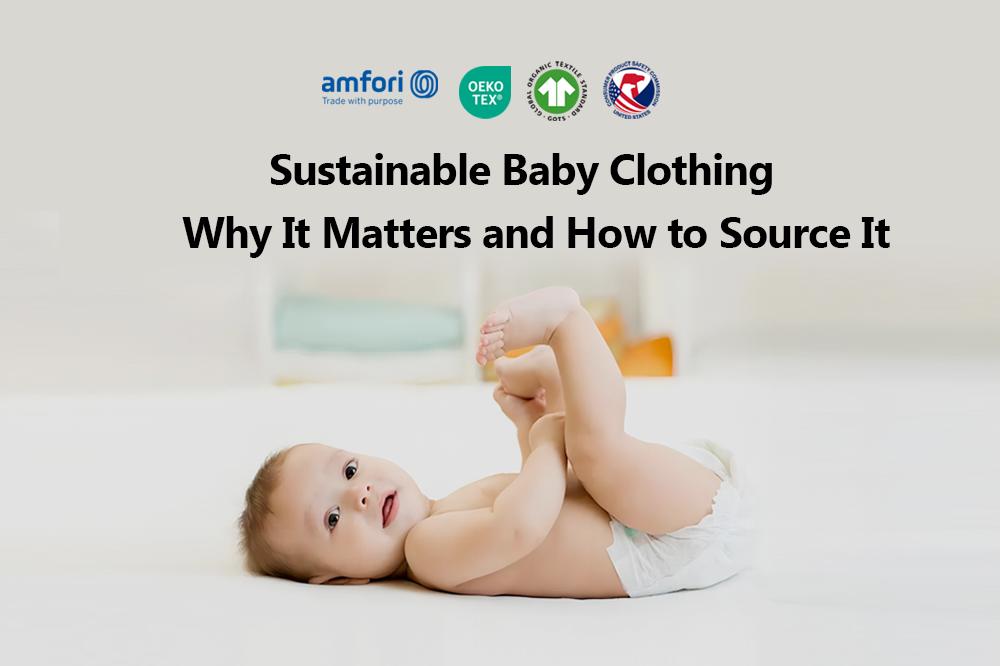In a world increasingly mindful of its environmental footprint, the quest for sustainable living has expanded into every corner of our lives, including the tiniest wardrobes. Enter sustainable baby clothing—a gentle embrace of eco-kind materials and ethical practices designed not just to pamper the delicate skin of our little ones, but also to safeguard the planet they will inherit. From organic cotton onesies to bamboo sleep suits, this new wave of baby apparel marries comfort and conscience, promoting a nurturing surroundings where both children and nature can thrive. In this article, we’ll explore the principles behind sustainable baby clothing, the benefits of choosing organic fabrics, and how these green choices reflect a broader commitment to sustainability and obligation. Join us as we delve into a world where every stitch is a step towards a healthier future for our children and the Earth.
The Benefits of Organic Fabrics for Your Baby’s Skin
When it comes to choosing clothing for your little one, the skin’s delicate nature cannot be overstated.Organic fabrics,made from natural fibers free from harmful chemicals and synthetic materials,provide a safe and nurturing environment for babies. These materials, such as organic cotton, bamboo, and linen, are not only gentle on sensitive skin but also breathable, minimizing the risk of rashes and irritations. The soft texture of organic fabrics ensures that your baby feels agreeable throughout the day, whether they’re playing or sleeping.
Moreover, opting for organic fabrics contributes to a healthier planet. Benefits of organic fabrics include:
- Chemical-Free: Grown without pesticides or synthetic fertilizers.
- Sustainable: Eco-friendly production practices that promote biodiversity.
- Durable: High-quality materials that withstand washing and wear, extending the life of baby clothing.
In addition, organic farms often use methods that conserve water and soil health, making every piece of clothing a testament to environmentally responsible practices.By choosing organic, you’re not just protecting your baby’s skin, but also investing in a cleaner, healthier world for future generations.

Understanding Sustainable Materials: What Makes Clothing Eco-Friendly
When it comes to baby clothing,choosing materials that are both safe for your little one and kind to the environment is crucial. Organic cotton is a popular option,cultivated without harmful pesticides or synthetic fertilizers,ensuring that the fabric next to your baby’s skin is gentle and free from toxins. Additionally, fabrics made from bamboo are gaining traction, as this fast-growing plant requires minimal water and no chemicals in its processing, making it a sustainable choice. Other eco-friendly materials to consider include:
- Hemp: Naturally resistant to mold and pests, this fabric has a low environmental impact.
- TENCEL: Made from sustainably sourced wood, it’s biodegradable and produced in a closed-loop system.
- Recycled polyester: utilizing plastic waste, this material helps reduce landfill contributions.
In understanding what makes clothing eco-friendly, it’s essential to look at the lifecycle of the materials used. For example, sustainable garments often emphasize not just the raw materials, but also the manufacturing processes. Ethical labor practices, reduced water usage, and minimal carbon footprints are vital components of a sustainable clothing brand. Moreover, a key factor is the end-of-life disposal; opting for biodegradable fabrics means the garments can decompose naturally rather than contributing to landfill waste. Here’s a simple comparison of eco-friendly clothing attributes:
| Material | Biodegradable | Pesticide-Free | Water Usage |
|---|---|---|---|
| Organic Cotton | Yes | Yes | Moderate |
| Bamboo | Yes | Yes | Low |
| Hemp | Yes | Yes | Very Low |
| TENCEL | Yes | Yes | Low |

Choosing the Right Brands: Top Recommendations for Green Baby Apparel
When it comes to selecting the perfect outfits for your little ones, opting for brands that prioritize sustainability is essential. Here are some top recommendations for green baby apparel that marry comfort, style, and environmental responsibility:
- Finn + Emma: This brand offers whimsical designs crafted from organic cotton and non-toxic dyes.Their garments are designed with both safety and style in mind, ensuring your baby looks adorable while feeling cozy.
- Kate Quinn: Known for their modern, stylish designs, Kate Quinn uses organic fabrics and ensures ethical production. Their pieces combine vibrant colors with playful patterns, perfect for dressing your young one in sustainability.
- Nature Baby: Hailing from New Zealand, this brand focuses on using the finest organic materials and offers a range of essentials from clothing to sleepwear. Their eco-friendly practices make them a top choice for mindful parents.
- Burt’s Bees Baby: This well-loved brand specializes in organic baby clothing that is soft against your baby’s skin. their commitment to eco-conscious manufacturing supports a vision of lasting sustainability.
For a more in-depth look, consider the following comparison of some standout brands:
| Brand | Material | Noteworthy Features |
|---|---|---|
| Finn + Emma | Organic Cotton | Whimsical designs, non-toxic dyes |
| Kate Quinn | Organic cotton | Modern styles, vibrant patterns |
| Nature Baby | organic Cotton | Eco-friendly production, New Zealand origin |
| Burt’s Bees Baby | Organic Cotton | Soft, safe materials |
With these brands, you can feel confident that your baby’s clothing choices are not only fashionable but also support a healthier planet. Choosing sustainable options encourages a lifestyle of environmental awareness from the very beginning.

Caring for Sustainability: Tips to Extend the Life of Baby Clothing
To ensure your baby’s organic clothing lasts as long as possible, it’s essential to adopt a few simple yet effective care practices. Start by washing clothes in cold water to minimize fabric wear and preserve colors. Avoid harsh detergents; instead, opt for plant-based, eco-friendly detergents that are gentle on both your baby’s skin and the environment.When drying, choose air drying over tumble drying whenever possible—this not only contributes to sustainability but also prolongs the lifespan of delicate fibers.
Another vital aspect of caring for sustainable baby clothing is proper storage. Keep garments in a cool, dry place to prevent mildew and fiber degradation. It’s also an excellent idea to store outgrown clothes by placing them in breathable cotton bags rather of plastic bins, which can trap moisture. When it’s time to move on from a piece,consider giving it a second life through donations or swaps with other parents. Not only does this minimize waste, but it also supports a community-focused and sustainable lifestyle.
Insights and Conclusions
As we wrap up our exploration of sustainable baby clothing, it’s clear that achieving a balance between nurturing our little ones and caring for our planet is not only possible but imperative.By choosing organic,gentle,and green materials,we not only offer our babies the utmost comfort but also pave the way for a healthier environment for generations to come. Every purchase made with sustainability in mind is a small yet impactful step toward a brighter future. So, as you fill your nursery with soft, eco-friendly fabrics, remember that in each stitch lies a commitment to both your child and the Earth. Embrace the journey of parenting with style, mindfulness, and an unwavering dedication to creating a sustainable world—one outfit at a time.

